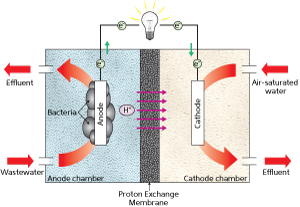
Fig. 1: Schematic diagram of a typical microbial fuel cell consisting of an anaerobic anode chamber and an aerobic cathode chamber separated by a proton exchange membrane. Bacteria at the anode oxidize organic matter (e.g. wastewater) before the electrons (e–) pass through an external circuit and produce current. Protons (H+) migrate through the solution across the membrane to the cathode where they combine with oxygen and electrons to form water.
© 2010 Y. Zeng
Once a pipedream, devices that can generate electricity while purifying wastewater have come a step closer to reality now that a microbial fuel cell (MFC) has been successfully modeled by a multinational team led by Yingzhi Zeng of the A*STAR Institute of High Performance Computing in Singapore. Zeng’s team developed a numerical MFC model similar to those previously developed for chemical fuel cells.
MFCs transform chemical energy into electrical energy directly by exploiting biochemical reactions performed by bacteria. Unlike chemical fuel cells that use organic chemicals such as methanol for fuel, MFCs work at room temperature and atmospheric pressure, and do not require precious metals as catalysts (Fig. 1).
“Perhaps the biggest advantage of MFCs is that they can be fed with organic waste, which means that they could be used to treat wastewater while simultaneously generating electricity,” explains Zeng.
Recognizing that overcoming technological hurdles to realize devices powered by MFCs requires a multidisciplinary approach, Zeng and his co-workers decided to use modeling. “Experimental assessment of MFCs in a myriad of possible designs, configurations and operating conditions is both time-consuming and costly, and this is where numerical modeling could come to the rescue, saving time and money,” says Zeng.
Zeng and his team, including experts in fuel cell technology from Korea, started by considering a simple MFC fuelled by acetate, an ecologically abundant organic chemical used by many bacteria for energy in anoxic environments. Their model successfully simulated the voltage and fuel concentration of the fuel cell as experimentally determined in the laboratory, as well as the influence of various factors affecting power generation. They then extended the model to simulate the operational characteristics of a similar MFC fuelled by artificial wastewater containing glucose and glutamic acid.
Despite their great promise and the need to develop renewable energy, present MFCs produce significantly less power than conventional chemical fuel cells, and the technology has not yet been transferred from the laboratory to full-scale industrial or commercial applications.
Zeng and his co-workers found that the performance of MFCs is limited by the reactions at the cathode, and that power output can be boosted by changes the fuel flow rate periodically, with implications for the design and operation of future MFCs.
“Our method is relatively simple and easy to implement, and should provide a framework for the comprehensive modeling of other MFC types. We hope that it will facilitate the development of highly efficient experimental MFCs that can be scaled up for industrial use,” says Zeng.
The A*STAR-affiliated researchers mentioned in this highlight are from the Institute of High Performance Computing.



